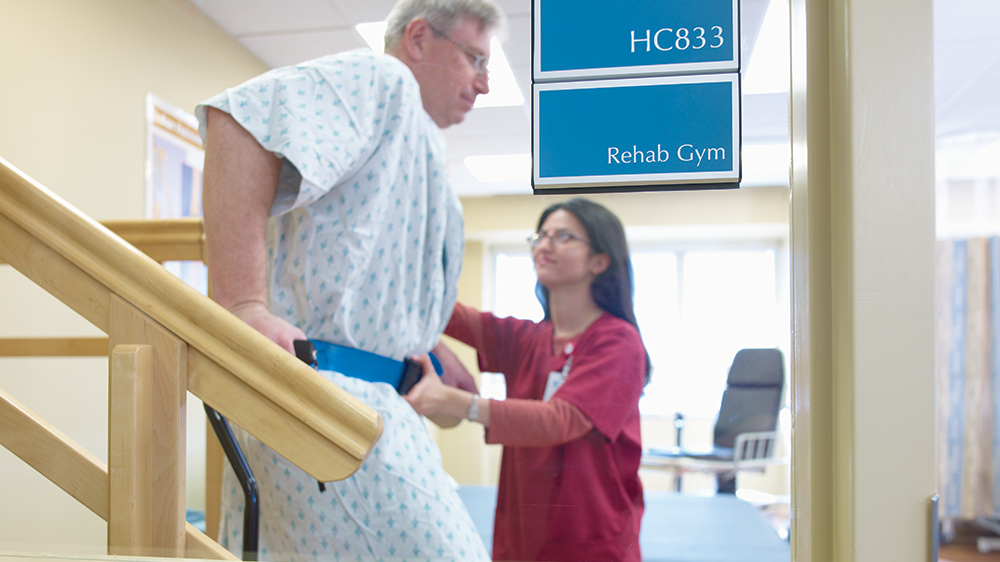Mike's Double Knee Replacement Story

With Two New Knees, Walking Is Easier And Life Is Better
Walking for me was slow and labored,” said Mike Rawe, 68. “My knees were noticeably bowed – each knee looked like the letter ‘S.’ My doctor told me I would know when it was time for knee replacement surgery, and he was right.”
“When it comes to treating joint pain, surgery is the last resort. We always explore all conservative treatment options first,” said Zohair Alam, MD, medical director, Joint Program, Holy Cross Hospital. For Mike, that meant trying over-the-counter and prescription medications, as well as injections in both knees to lubricate the joints and reduce inflammation. These treatments brought short-term relief, but Mike’s knees continued to hurt. Dr. Alam recommended that Mike have joint replacement surgery for both knees.
“Each knee had a lot of deformity due to osteoarthritis. It was best to replace one knee at a time,” said Dr. Alam.
Prior to surgery, Mike attended a Holy Cross joint replacement class. “The class was very informative and good for me because I didn’t know what to expect,” said Mike. He also continued to work out on his stationary bike at home to prepare for surgery by strengthening the muscles and supportive structures around his knees.

Overcome Joint Problems
JOINT INFO SESSION
Attend a free virtual information session to learn more about the process of hip or knee replacement
Register TodayOriginally scheduled for April, Mike’s first knee surgery was postponed until May due to the pandemic. “I felt completely comfortable having my surgery at Holy Cross Hospital. The day before my surgery I was tested for COVID-19 and after a negative result, when I arrived for surgery, the hospital has a dedicated path and care area so I wasn’t exposed to the virus,” said Mike.
During Mike’s surgery, after making the incision and exposing the joint, Dr. Alam removed just the arthritis, leaving as much bone as possible. The implant is sized and aligned and then placed on the end of the bones. Holy Cross Health has the expertise to correct deformities and optimize outcomes.
“The arthritis is gone the minute the surgery is done,” said Dr. Alam. “Patients tell us that even while recovering, they can already feel that their knee is better because they don’t have pain from arthritis.”
Changes in how anesthesia is administered and how early physical therapy is started have led to significant improvement in patient comfort and shorter recovery. During surgery, a regional nerve block is given to minimize post-operative pain. Physical therapy begins immediately after surgery, while the patient is still in the recovery room. Later that day, the patient is up and walking.
More than 85 percent of patients go directly home and receive physical therapy there as opposed to going to a skilled nursing facility. “Multiple scientific studies show that most patients do better and have fewer complications if they are discharged to go home the day of surgery or early the next day,” said Tariq Nayfeh, MD, subsection chair, Orthopedics, Holy Cross Germantown Hospital. “At both Holy Cross hospitals, our surgeons and nursing, anesthesiology and rehabilitation staff work to meet national and international standards of excellence for joint replacement surgery.”
Mike went home the same day of his surgery and had a few weeks of in-home physical therapy. “My first knee healed nicely,” he said. Within three weeks, he was able to walk on his own without a cane, drive and go grocery shopping. “I was ready to get the second surgery out of the way as soon as I could because Dr. Alam told me my bad knee could affect my good knee.” Everything went well with Mike’s second knee replacement surgery in July — and his recovery was quicker. “The care I received from Dr. Alam and the Holy Cross Hospital team was excellent,” said Mike. “I appreciate how they shared information and were straightforward and focused on me. My knees are feeling great now. What I really like is that I can easily go up and down the two flights of stairs in my home.”
Information About Joint Care


